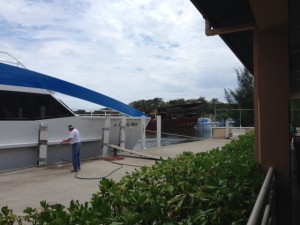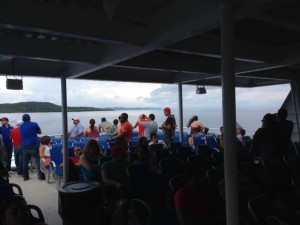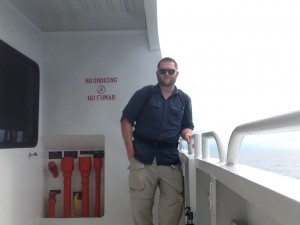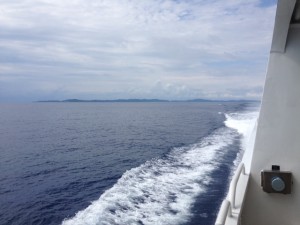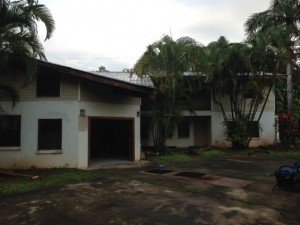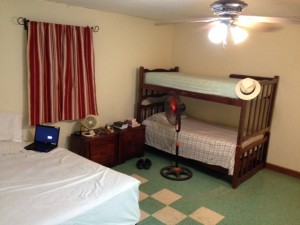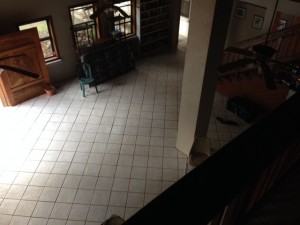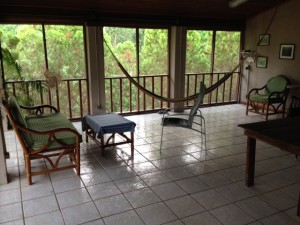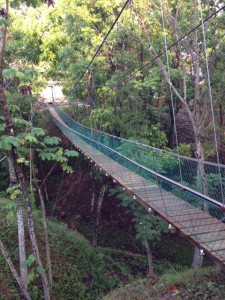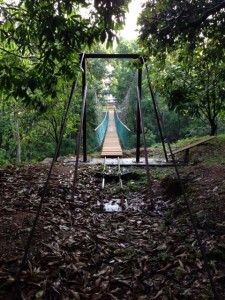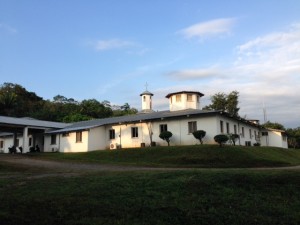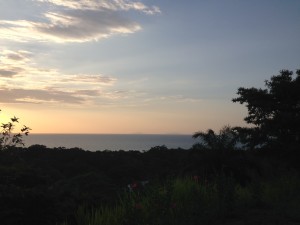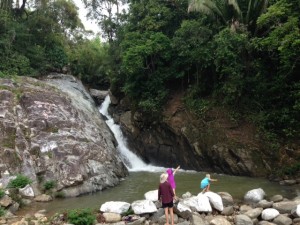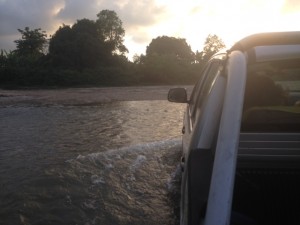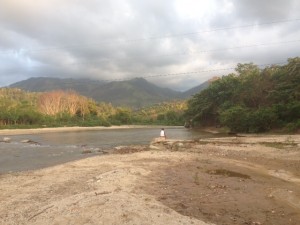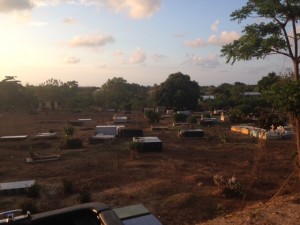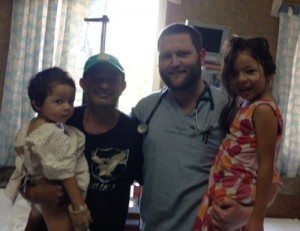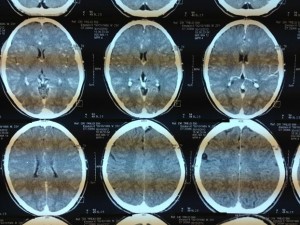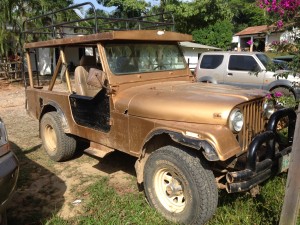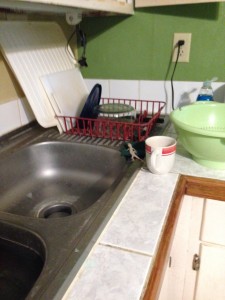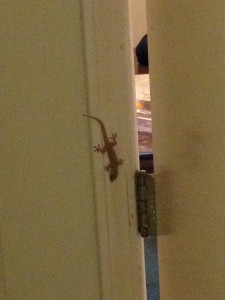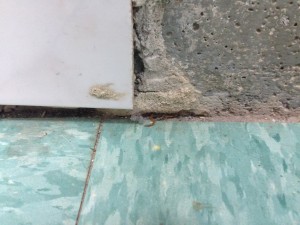This is my first ever attempt at blogging, to let’s all get our expectations down to a reasonable level. To start with, I had to get from the airport in Roatan to the ferry, which would take me to La Ceiba. This provided me my first opportunity to dust off my rusty Spanish skills. I quickly failed in doing so as the taxi driver told me the cost was “veinte cinco”, or twenty-five. I thought that seemed a bit steep, but paid him the $25 since wasn’t really in a position to argue. If I didn’t make the ferry, I had no idea where I’d be staying the night or how I would meet up with my contact person at a time other than what we had originally designated. After a short taxi ride, I got on the ferry and later realized the driver meant 25 lempiras, the local currency, which amounts to a little over a dollar. I took the ferry from the island of Roatan to La Ceiba. It took about an hour and a half and could hold several hundred people on board.
Once I arrived in La Ceiba, I met Peter, an ER doc from Arizona who’s acting as my “sponsor”. We headed to the grocery store and bought supplies for the next couple of weeks, loaded them up in the back of his truck along with several containers full of gasoline, and headed east for about another hour over bumpy roads until we finally arrived at the medical complex, which is near the town of Balfate. They’ve set me up in my own little one bed, one bath apartment. It’s in a larger complex of apartments that has sort of an open air theme.
There are a couple suspension bridges between my house and hospital. You can also see the ocean from the property.
The next day I took a walk to the beach, which is only about ten minutes away. On the way there once I got off the road, I had to first pass through a field of palm oil trees, which believe it or not are used to make palm oil. Afterward, I had to pass through sort of a lagoon-like area with these big towering trees with really thick trunks. I’m not sure what they’re called, but they were pretty impressive.
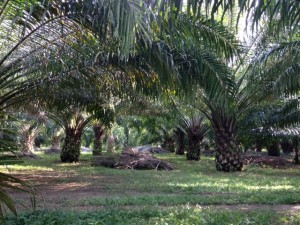


Peter and his family invited me to go with them to a nearby waterfall later on in the afternoon. On the way there and back, we had to ford a river in his truck because the bridge had been washed out.
We passed this cemetery on the way back, which I was able to photograph from my bumpy seat in the truck bed.
On Monday I started working in the hospital and clinic. It can get a bit warm at times and there’s no air conditioning. The humidity is almost always about 100% since we’re right next to the ocean, so everybody just sweats all the time and there’s not much anyone can do about it, haha…but I get to go down to the beach before work and snorkel, so you can’t really beat that.
I usually get to the hospital a little before 8 and see the people I’ve admitted. I was on call overnight that first Monday, so I quickly rounded up some people to admit. The first one was a little boy named Fernando who basically just got dehydrated and needed some fluids overnight. Here’s a picture of him and his family:
The second was a pregnant woman who came in at about 2:30 a.m. She was eclamptic and actively seizing when she arrived, so we had to do a crash c-section on her. Back at Research, we see a lot of people with preeclampsia but rarely full blown eclampsia. Apparently it happens not infrequently around here.
As far as clinic goes, I’m seeing anywhere from 6-10 patients per day. That’s actually less than I see back home, but it feels like a lot more work here…probably because I’m still kind of unfamiliar with their system and also the fact that everybody here speaks Spanish. I’ve only met one other person (who’s not a missionary) who speaks any amount of English. I can already tell my Spanish is improving. That first day was a real struggle though, after not really speaking Spanish on a regular basis for several years. Luckily there’s a translator here who I can occasionally have step in if I really get stuck, but for the most part I’ve just been trudging through as much as possible.
On the second day, I had a patient with a virus that I had previously never heard of. It’s called Chikungunya, and basically causes fever and joint pain. I guess they see it fairly often around here. There’s not really any specific cure, so I just gave her supportive treatment and return precautions.
One other patient I had that day was a 4 year old girl who had a fall and broke both the bones in her forearm. It’s really interesting working here because we don’t have any other doctors to consult with. When you get an xray, you’re the one who has to read it. There’s no radiologist to call up if you can’t figure it out for yourself. This was a pretty obvious fracture luckily. We had to consciously sedate her, which again was a little bit different of a process than how we do it in the states. Much less monitoring involved. We just gave her some Ketamine and were able to yank her arm back into the correct position to apply a cast. I’ll see her back in about two and a half weeks to remove it.
The other people I saw that day had some pretty common things I see a lot back home. One was a girl with pityriasis that I treated with an antifungal ointment. The other was a guy with an enlarged prostate who we ultrasounded. He’ll follow up with a urologist and probably have it removed. Another person was a guy with abdominal pain probably caused by a kidney stone, but I don’t really know. One guy had an asthma exacerbation caused by an upper respiratory infection. I think that was it that day.
After work I walked down the road a ways to the children’s center and there were some guys outside building a hut. They have to climb up these trees about 40 feet and chop down the branches with a machete. Then they dry the leaves out on the ground for a few days. Once that’s done, they bundle a few rows of these branches together and lash them to the frame. The guy I talked to about it, Silvino, said the roof on one of these buildings can last about 6-7 years, or maybe longer depending on how many rows of branches they lash together.
The next day my clinic patients included…
• 45 year old female with constipation
• 5 year old male with cough variant asthma and his 6 year old sister who had the same thing
• 65 year old male with right shoulder arthritis who got a steroid injection
• 18 day old female with a viral upper respiratory infection
• 5 year old female with community acquired pneumonia requiring antibiotics
It’s kind of nice that clinic here only lasts from 8 am until 1 or 2 pm, so you can’t really get overwhelmed with too many patients. Worst case scenario is you get an hour or so behind and are still done around 3 pm.
After clinic ended, a 39 year old G6P5 came in at about 4 cm. I got her admitted and watched her all afternoon because I was the one on call overnight. She wasn’t really doing anything, but I decided to keep her because in the words of one of our distinguished faculty members, Dr. Philgreen, “you can never trust a grand multip”.
Later on a 14 month old came in to the ER with “fever”, diarrhea, vomiting, and decreased oral intake for the last few days. She was actually afebrile and didn’t really look that dehydrated, so I just give her some fluids and had her come back in the morning for lab work and a follow up visit (we can’t do labs at night here, so there’s not really any point in just baby-sitting, plus the nurses are always stretched pretty thin and the hospital census is kind of high at the moment).
A little bit later on that night I ended up delivering the mom mentioned above, so I’m glad I didn’t send her home even though she didn’t seem to be in active labor. The baby was huge and at first I couldn’t pull it out because its shoulders were so big. I had to exercise a couple of shoulder dystocia maneuvers and was finally able to get it out after about 45 seconds of struggling…that’s always a bit scary. Another lady came in as well and delivered a little bit later at around 4 am. I also admitted a 66 yo F who was having a COPD exacerbation and maybe has a pneumonia by looking at her xray. She’s still in the hospital now and I’ve started up some antibiotics on her. The little girl who got dehydrated came back in to see me in clinic the next morning and I gave her some more fluids and sent her home.
The next day, clinic was kind of a blur. The most interesting thing I saw was a 23 yo M with seizure disorder, which has been well controlled on his current meds. He’s only had the disorder for about 4 years, and the etiology is thought to be due to neurocysticercosis, which in the developing world is one of the most common causes of seizure disorder. Here’s a view of his CT, where you can see a number of calcified granulomas throughout his temporal lobes:
Here are a few other fun pictures I’ve taken from around the complex:
This is just an awesome jeep that mine aspires to emulate one day.
These are some pics of my roommate, Sr. Guillermo. The other cuddly little guy is barely visible, but is a scorpion I found in the bathroom. He’s about ten seconds away from getting kicked out of the house.

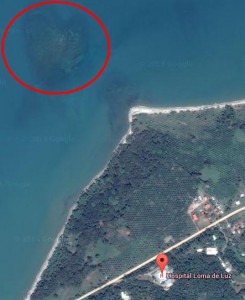
Here’s a satellite view of my house in relation to the beach. There’s also a giant coral reef a few hundred yards off the shore that has tested my ability to not have a heart attack while exercising.
Mother’s day flowers I (digitally) sent my mom. I found these all within about 50 feet of my house.
I’m on call again at the moment. I just got back from the ER where I saw a 53 yo F with probably a left hip strain. It started immediately after she tried lifting her leg while getting out of a car. She did have a temp to 100.5 F, but I don’t think she has a septic joint. Unfortunately we can’t really get labs or imaging at night without calling someone in from far away, so we just have to sort of make a guess based on their clinical appearance. I gave her a shot of Toradol and some Tylenol and NSAIDs to get her through the next couple of days until clinic reopens unless things get worse.

